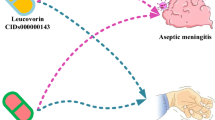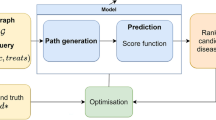Abstract
The polypharmacy side effect prediction problem considers cases in which two drugs taken individually do not result in a particular side effect; however, when the two drugs are taken in combination, the side effect manifests. In this work, we demonstrate that multi-relational knowledge graph completion achieves state-of-the-art results on the polypharmacy side effect prediction problem. Empirical results show that our approach is particularly effective when the protein targets of the drugs are well-characterized. In contrast to prior work, our approach provides more interpretable predictions and hypotheses for wet lab validation.
Access this chapter
Tax calculation will be finalised at checkout
Purchases are for personal use only
Similar content being viewed by others
Notes
- 1.
Available at http://snap.stanford.edu/decagon.
References
Bordes, A., Usunier, N., García-Durán, A., Weston, J., Yakhnenko, O.: Translating embeddings for modeling multi-relational data. In: Advances in Neural Information Processing Systems \(26\) (2013)
Cheng, F., Zhao, Z.: Machine learning-based prediction of drug-drug interactions by integrating drug phenotypic, therapeutic, chemical, and genomic properties. J. Am. Med. Inform. Assoc. 21(e2), e278–e286 (2014)
Fishman, D.A., Liu, Y., Ellerbroek, S.M., Stack, M.S.: Lysophosphatidic acid promotes matrix metalloproteinase (MMP) activation and MMP-dependent invasion in ovarian cancer cells. Cancer Res. 61(7), 3194–3199 (2001)
García-Durán, A., Niepert, M.: KBLRN: end-to-end learning of knowledge base representations with latent, relational, and numerical features. In: Proceedings of the 34th Conference on Uncertainty in Artificial Intelligence (2018)
Hinton, G.E.: Training products of experts by minimizing contrastive divergence. Neural Comput. 14(8), 1771–1800 (2002)
Kuhn, M., Letunic, I., Jensen, L.J., Bork, P.: The SIDER database of drugs and side effects. Nucl. Acids Res. 44(D1), D1075–D1079 (2016)
Manicone, A.M., McGuire, J.K.: Matrix metalloproteinases as modulators of inflammation. Semin. Cell Dev. Biol. 19(1), 34–41 (2008)
Munshi, H.G., Wu, Y.I., Ariztia, E.V., Stack, M.S.: Calcium regulation of matrix metalloproteinase-mediated migration in oral squamous cell carcinoma cells. J. Biol. Chem. 277(44), 41480–41488 (2002)
Sridhar, D., Fakhraei, S., Getoor, L.: A probabilistic approach for collective similarity-based drug-drug interaction prediction. Bioinformatics 32(20), 3175–3182 (2016)
Szklarczyk, D., Santos, A., von Mering, C., Jensen, L.J., Bork, P., Kuhn, M.: STITCH 5: augmenting protein-checical interaction networks with tissue and affinity data. Nucl. Acids Res. 44, D380–D384 (2016)
Tatonetti, N.P., Ye, P.P., Daneshjou, R., Altman, R.B.: Data-driven prediction of drug effects and interactions. Sci. Transl. Med. 4(125), 125ra31 (2012)
Yang, B., tau Yih, S.W., He, X., Gao, J., Deng, L.: Embedding entities and relations for learning and inference in knowledge bases. In: Proceedings of the 3rd International Conference on Learning Representations (2015)
Zhang, W., Chen, Y., Liu, F., Luo, F., Tian, G., Li, X.: Predicting potential drug-drug interactions by integrating chemical, biological, phenotypic and network data. BMC Bioinform. 18, 18 (2017)
Zitnik, M., Agrawal, M., Leskovec, J.: Modeling polypharmacy side effects with graph convolutional networks. Bioinformatics 34(13), 457–466 (2018)
Author information
Authors and Affiliations
Corresponding author
Editor information
Editors and Affiliations
Rights and permissions
Copyright information
© 2019 Springer Nature Switzerland AG
About this paper
Cite this paper
Malone, B., García-Durán, A., Niepert, M. (2019). Knowledge Graph Completion to Predict Polypharmacy Side Effects. In: Auer, S., Vidal, ME. (eds) Data Integration in the Life Sciences. DILS 2018. Lecture Notes in Computer Science(), vol 11371. Springer, Cham. https://doi.org/10.1007/978-3-030-06016-9_14
Download citation
DOI: https://doi.org/10.1007/978-3-030-06016-9_14
Published:
Publisher Name: Springer, Cham
Print ISBN: 978-3-030-06015-2
Online ISBN: 978-3-030-06016-9
eBook Packages: Computer ScienceComputer Science (R0)




